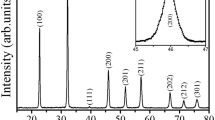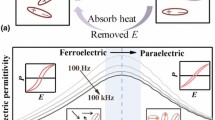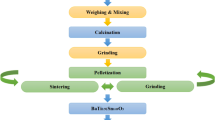Abstract
The electrocaloric effect (ECE) refrigeration is environment-friendly and is of high efficiency for replacing traditional compression refrigeration. Herein, 0.98(K0.48Na0.535)(1−x)Lix(Nb0.99Sb0.01) O3–0.02BaZrO3 (xLi) ceramics are fabricated by a solid-state method, and the microstructure, dielectric properties, and ECE are investigated in detail. A large ECE is achieved in xLi ceramics near ambient temperature benefiting from phase boundary design by appropriate composition engineering. An indirect adiabatic temperature change (ΔT) of xLi ceramics with x = 0.03, 0.05, and 0.07 are 0.26 K, 0.29 K, and 0.36 K under an electric field of 60 kV cm–1, respectively. A direct ΔT of 0.226 K is obtained at 70 °C under 50 kV cm−1 in 0.07Li ceramic. In addition, the temperature span (Tspan) is up to 50 K in 0.07Li ceramic due to broad orthorhombic–tetragonal phase transition peak. This work not only provides an effective way to develop an excellent performance electrocaloric material but also expands the application area of potassium–sodium niobate ceramics in solid-state refrigeration.





Similar content being viewed by others
Data availability
Data will be made available on request.
References
M. Guo, M. Wu, W. Gao, B. Sun, X. Lou, Giant negative electrocaloric effect in antiferroelectric PbZrO3 thin films in an ultra-low temperature range. J. Mater. Chem. C. 7(3), 617–621 (2019)
F. Zhuo, Q. Li, H. Qiao, Q. Yan, Y. Zhang, X. Xi, X. Chu, X. Long, W. Cao, Field-induced phase transitions and enhanced double negative electrocaloric effects in (Pb, La)(Zr, Sn, Ti)O3 antiferroelectric single crystal. Appl. Phys. Lett. 112(13), 133901 (2018)
N. Zhang, T. Zheng, C. Zhao, X. Wei, J. Wu, Enhanced electrocaloric effect in compositional driven potassium sodium niobate-based relaxor ferroelectrics. J. Mater. Res. 36(5), 1142–1152 (2021)
J. Yang, Y. Zhao, L. Zhu, X. Hao, Enhanced electrocaloric effect of relaxor potassium sodium niobate lead-free ceramic via multilayer structure. Scripta Mater. 193, 97–102 (2021)
L. Zhu, X. Meng, J. Zhu, Y. Zhao, Y. Li, X. Hao, Enhanced room temperature electrocaloric effect in lead-free relaxor ferroelectric NBT ceramics with excellent temperature stability. J. Alloy. Compd. 892, 162241 (2022)
G.G. Wiseman, J.K. Kuebler, Electrocaloric effect in ferroelectric rochelle salt. Phys. Rev. 131(5), 2023–2027 (1963)
J.G. Bednorz, K.A. Müller, Sr1−xCaxTiO3: AnXYQuantum ferroelectric with transition to Randomness. Phys. Rev. Lett. 52(25), 2289–2292 (1984)
E. Birks, L. Shebanov, A. Sternberg, Electrocaloric effect in PLZT ceramics. Ferroelectrics 69(1), 125–129 (1986)
A.S. Mischenko, Q. Zhang, J.F. Scott, R.W. Whatmore, N.D. Mathur, Giant electrocaloric effect in thin-film PbZr(0.95)Ti(0.05)O3. Science 311(5765), 1270–1271 (2006)
C.M. Guvenc, U. Adem, Influence of aging on electrocaloric effect in Li+ doped BaTiO3 ceramics. J. Alloy. Compd. 791, 674–680 (2019)
R. Yin, J. Li, X. Su, S. Qin, C. Yu, Y. Hou, C. Liu, Y. Su, L. Qiao, T. Lookman, Y. Bai, Emergent enhanced electrocaloric effect within wide temperature span in laminated composite ceramics. Adv. Func. Mater. 32(5), 2108182 (2021)
F. Li, J. Li, J. Zhai, B. Shen, S. Li, M. Zhou, K. Zhao, H. Zeng, Influence of structural evolution on electrocaloric effect in Bi0.5Na0.5TiO3-SrTiO3 ferroelectric ceramics. J. Appl. Physics. 124(16), 164108 (2018)
G. Li, J. Li, F. Li, Y. Li, X. Liu, T. Jiang, F. Yan, X. He, B. Shen, J. Zhai, Electrocaloric effect in BNT-based lead-free ceramics by local-structure and phase-boundary evolution. J. Alloy. Compd. 817, 152794 (2020)
X. Wang, J. Wu, B. Dkhil, B. Xu, X. Wang, G. Dong, G. Yang, X. Lou, Enhanced electrocaloric effect near polymorphic phase boundary in lead-free potassium sodium niobate ceramics. Appl. Phys. Lett. 110(6), 063904 (2017)
B. Zhang, J. Wu, X. Wang, X. Cheng, J. Zhu, D. Xiao, Rhombohedral–orthorhombic phase coexistence and electrical properties of Ta and BaZrO3 co-modified (K, Na)NbO3 lead-free ceramics. Curr. Appl. Phys. 13(8), 1647–1650 (2013)
C. Zhao, J. Yang, Y. Huang, X. Hao, J. Wu, Broad-temperature-span and large electrocaloric effect in lead-free ceramics utilizing successive and metastable phase transitions. J. Mater. Chem. A. 7(44), 25526–25536 (2019)
L. Zhang, C. Zhao, T. Zheng, J. Wu, Large electrocaloric effect in (Bi0.5Na0.5)TiO3-based relaxor ferroelectrics. ACS Appl Mater Interfaces. 12(30), 33934–33940 (2020)
X. Wei, C. Zhao, T. Zheng, X. Lv, L. Zhang, B. Li, J. Wu, Understanding the enhanced electrocaloric effect in BaTiO3-based ferroelectrics at critical state. Acta Mater. 227, 117735 (2022)
Y. Zhao, J. Du, J. Yang, L. Zhu, Y. Wang, Y. Li, X. Hao, Large Room-Temperature Electrocaloric Response Realized in Potassium-Sodium Niobate by a Relaxor Enhancement Effect and Multilayer Ceramic Construct. ACS Appl Mater Interfaces. 14(9), 11626–11635 (2022)
R. Gaur, N. Sharma, S. Kharbanda, S. Singh, Enhanced ferroelectric and electrocaloric properties in CuO-modified lead-free (Na0.5K0.5)NbO3 ceramics for solid-state cooling application. Mater. Sci. Eng: B. 261, 114767 (2020)
A. Gupta, R. Kumar, S. Singh, Coexistence of negative and positive electrocaloric effect in lead-free 0.9(K0.5Na0.5)NbO3-0.1SrTiO3 nanocrystalline ceramics. Scripta Mater. 143, 5–9 (2018)
M. Kosec, V. Bobnar, M. Hrovat, J. Bernard, B. Malic, J. Holc, New lead-free relaxors based on the solid K0.5Na0.5NbO3-SrTiO3 solution. J. Mater. Res. 19(6), 1849–1854 (2011)
R. Kumar, D. Khurana, A. kumar, S. Singh, Giant negative electrocaloric effect and energy storage response in 0.94(K0.5Na0.5)NbO3-0.06SrMnO3 nanocrystalline ceramics. Cerami. Int. 44(17), 20845–20850 (2018)
J. Koruza, B. Rožič, G. Cordoyiannis, B. Malič, Z. Kutnjak, Large electrocaloric effect in lead-freec K0.5Na0.5NbO3-SrTiO3ceramics. Appl. Phys. Lett. 106(20), 202905 (2015)
J. Yang, Y. Zhao, X. Lou, J. Wu, X. Hao, Synergistically optimizing electrocaloric effects and temperature span in KNN-based ceramics utilizing a relaxor multiphase boundary. J. Mater. Chem. C. 8(12), 4030–4039 (2020)
M. Aissa, M. Zannen, M. Benyoussef, J. Belhadi, M. Spreitzer, Z. Kutnjak, M. El Marssi, A. Lahmar, Large direct and inverse electrocaloric effects in lead-free Dy doped 0.975KNN-0.025NBT ceramics. Ceram. Int. 47(22), 31286–31293 (2021)
Q. Liu, J.-F. Li, L. Zhao, Y. Zhang, J. Gao, W. Sun, K. Wang, L. Li, Niobate-based lead-free piezoceramics: a diffused phase transition boundary leading to temperature-insensitive high piezoelectric voltage coefficients. J. Mater. Chem. C. 6(5), 1116–1125 (2018)
E. Hollenstein, M. Davis, D. Damjanovic, N. Setter, Piezoelectric properties of Li- and Ta-modified (K0.5Na0.5)NbO3 ceramics. Appl. Phys. Lett. 87(18), 182905 (2005)
G. Li, F. Yan, K. Zhu, C. Shi, G. Ge, J. Lin, Y. Shi, B. Shen, J. Zhai, Intelligent self-actuating lead-free cooling ceramics based on A-site defect engineering. Acta Mater. 227, 117750 (2022)
M. Zannen, A. Lahmar, Z. Kutnjak, J. Belhadi, H. Khemakhem, M. El Marssi, Electrocaloric effect and energy storage in lead free Gd0.02Na0.5Bi0.48TiO3 ceramic. Solid State Sci. 66, 31–37 (2017)
W.P. Cao, W.L. Li, X.F. Dai, T.D. Zhang, J. Sheng, Y.F. Hou, W.D. Fei, Large electrocaloric response and high energy-storage properties over a broad temperature range in lead-free NBT-ST ceramics. J. Eur. Ceram. Soc. 36(3), 593–600 (2016)
W.P. Cao, W.L. Li, T.R.G.L. Bai, Y. Yu, T.D. Zhang, Y.F. Hou, Y. Feng, W.D. Fei, Enhanced electrical properties in lead-free NBT-BT ceramics by series ST substitution. Ceram. Int. 42(7), 8438–8444 (2016)
S. Belkhadir, A. Neqali, M. Amjoud, D. Mezzane, A. Alimoussa, E. Choukri, Y. Gagou, I. Raevski, M. El Marssi, I.A. Luk’yanchuk, B. Rožič, Z. Kutnjak, Structural, dielectric and electrocaloric properties of (Ba0.85Ca0.15)(Ti0.9Zr0.1-xSnx)O3 ceramics elaborated by sol-gel method. J. Mater. Sci: Mater. Electr. 30(15), 14099–14111 (2019)
Y. Bai, G.-P. Zheng, S.-Q. Shi, Abnormal electrocaloric effect of Na0.5Bi0.5TiO3-BaTiO3 lead-free ferroelectric ceramics above room temperature. Mater. Res. Bulletin. 46(11), 1866–1869 (2011)
X. Yan, M. Zhu, Q. Wei, S.-G. Lu, M. Zheng, Y. Hou, Large electrocaloric effect in tetragonal perovskite 0.03Bi (Mg1/2Ti1/2)O3-0.97(0.875Bi1/2Na1/2TiO3-0.125BaTiO3) lead-free ferroelectric ceramics. Scripta Mater. 162, 256–260 (2019)
Acknowledgements
This work was supported by the National Natural Science Foundation of China (grant No. 52102136), the Doctoral Program for Natural Science Foundation of Inner Mongolia Autonomous Region (Grant No. 2020BS05005), the Major Program for Science and Technology of Inner Mongolia Autonomous Region (Grant No. 2019ZD12), and the Support Program for “Grassland Talents” Innovation Team of Inner Mongolia (Rare Earth Modified Lead-free Ferroelectric Multilayer Ceramic Capacitors Innovative Talent Team).
Funding
The National Natural Science Foundation of China, No. 52102136, Ye Zhao, the Doctoral Program for Natural Science Foundation of Inner Mongolia Autonomous Region,No. 2020BS05005,Ye Zhao, the Major Program for Science and Technology of Inner Mongolia Autonomous Region, No. 2019ZD12, Xihong Hao, and the Support Program for “Grassland Talents” Innovation Team of Inner Mongolia, Xihong Hao.
Author information
Authors and Affiliations
Contributions
YW performed the experiment and manuscript preparation. YZ contributed significantly to analysis and manuscript preparation. LZ performed the experiment. YL and XH helped perform the analysis with constructive discussions.
Corresponding authors
Ethics declarations
Conflict of interest
The authors declare no competing financial interest.
Additional information
Publisher's Note
Springer Nature remains neutral with regard to jurisdictional claims in published maps and institutional affiliations.
Rights and permissions
About this article
Cite this article
Wang, Y., Zhu, L., Zhao, Y. et al. Enhanced electrocaloric effect in lead-free ferroelectric potassium–sodium niobate ceramics benefiting from phase boundary design. J Mater Sci: Mater Electron 33, 17322–17330 (2022). https://doi.org/10.1007/s10854-022-08609-8
Received:
Accepted:
Published:
Issue Date:
DOI: https://doi.org/10.1007/s10854-022-08609-8




